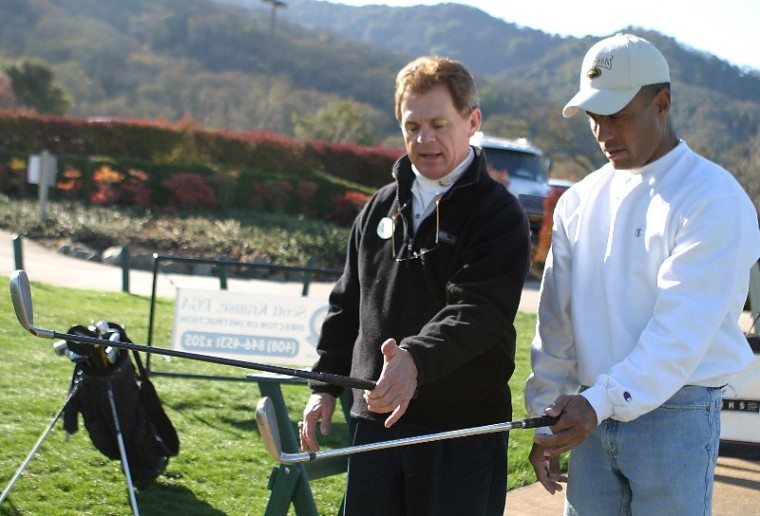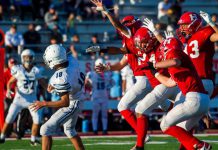
Pro enjoys educating others as much as playing
Scott Krause has read more than 200 books and all of them have
been on one subject: golf instruction.
For that reason alone, it’s no wonder that the Northern
California Professional Golfers’ Association named Krause, Eagle
Ridge’s director of instruction, Northern California’s Teacher of
the Year.
But for Krause, 57, that distinct honor was bestowed on him last
year for a lot more than his ability to read golf books. He won the
prestigious award for his ongoing desire to perfect his teaching
while conveying to his students the most effective way to hit a
golf ball by taking them through the toughest component of the game
to master: the swing itself.
Pro enjoys educating others as much as playing
Scott Krause has read more than 200 books and all of them have been on one subject: golf instruction.
For that reason alone, it’s no wonder that the Northern California Professional Golfers’ Association named Krause, Eagle Ridge’s director of instruction, Northern California’s Teacher of the Year.
But for Krause, 57, that distinct honor was bestowed on him last year for a lot more than his ability to read golf books. He won the prestigious award for his ongoing desire to perfect his teaching while conveying to his students the most effective way to hit a golf ball by taking them through the toughest component of the game to master: the swing itself.
Since turning professional in 1982, teaching the game of golf has always given Krause, a Class-A professional since 1993, the most enjoyment.
Recently, we spoke with Krause and discussed his methodology and how he has taken the golf lesson, which is considered a tedious duty for many professionals, and made it into an enjoyable art form.
Q: Most pros do enjoy teaching, but it’s just another part of the job. This is all you want to do. Why?
A: I enjoy it. I’ve been at Eagle Ridge for five years and writing weekly columns for the Pinnacle since 2002. Most people would have run out of teaching ideas by now but I’m constantly reading about the game and I enjoy it.
Q: What do you enjoy most?
A: I like dealing with people and seeing them get better. It’s a process. You don’t get immediate results, but that’s what makes it so rewarding. I like to see people get better so that they can play better and enjoy themselves more.
Q: Have you ever had a student that came to you as a complete hacker that left as a single-digit player?
A: I’ve had a player drop 15 points off his index and I’ve had people get down to about a 10 handicap, but to go from a complete hack to a single digit handicapper would take years and a lot of dedication on their part. It’s a lifestyle change to get there. People can become single-digit players. I’ve taught a lot of low handicappers but to get real low takes a different level of commitment. The biggest leap in golf is going from a 15 to a 6 handicap.
Q: Growing up I remember Hogan’s book on the five easy lessons and Nicklaus’ “Golf My Way.” What books have you gotten the most out of?
A: I have books that date back to the 1800s on the game all the way to today. It’s like a hobby for me. From a student or teacher’s standpoint, the best book is the one that fits your style. The one common denominator is that they all start out with a basic knowledge of what you are doing, meaning that they first focus on fundamentals. If I hadn’t read all of these books I would never have been able to write all of the weekly tips that I write for The Pinnacle. Most pros would run out of what to say by now, but I read so much that I might have just one or two sentences jump out at me that will give me an idea for a tip.
Q: What is the most common swing flaw that you see your students make?
A: A lack of connection between the upper and lower body. I taught a club champion three years in a row that kept telling me that his swing was too flat. A swing is either like a merry-go-round or a Ferris wheel. It turned out his swing was actually more like a Ferris wheel (steeper plane) than what he thought. You get a lot of that disconnect. People think they do one thing when they actually do another.
Q: Is your swing different from what you think?
A: My swing is actually a good model for students to follow. But I’ve heard stories of teachers asking their students why they keep swinging back so far and they respond to the teacher that they have been swinging like that because the teacher himself was swinging like that (past parallel) without even knowing it.
Q: What makes the golf swing so interesting?
A: The subconscious actually controls it, and the subconscious doesn’t understand the negative. If you say, “don’t sit” to a dog, he’s going to sit anyway because his subconscious doesn’t understand don’t. And the same thing happens the same way when you say don’t hit it in the lake. What happens? You hit it in the lake.
Q: What is the key to making a consistent, repeatable swing?
A: If I have film of an amateur hitting balls and I stop it at impact the hips, legs and knees are aimed straight at the camera. If I see that same footage of a PGA Tour pro the right knee is pointed almost directly at the target. I tell my students that the swing is like slamming a door. The top and bottom of the door doesn’t move by itself – it works together.
Q: It sounds like the body disconnect or not having it work and getting it to work in unison is a major part of your teaching efforts.
A: The most common flaw is that the lower body doesn’t respond to the upper body. I try to get my students to use the legs and big muscles more. I tell them that a quarterback wouldn’t be able to throw the football as far if he were sitting in a chair. He has to use his body and so do you. It goes back to the door analogy again. I read that Tiger Woods’ dad used to tell him to shut the door on a short shot and slam the door on a long shot, but it’s all about getting that “door” to close together.
Q: It seems like the most common flaw of all weekend golfers is the slice. Why do people slice the ball?
A: They hit the side of the ball at impact not the back of it. I tell them that if I hit them in the chest at 100 mph at an angle it wouldn’t be a powerful as being hit 80 mph square. And that’s how they need to hit the golf ball.
Q: What do you ask your students on the first lesson?
A: I ask them why they’re getting the lesson in the first place. The most common answer I get is that they want to get better, but that’s not the right answer. The focus should be on improving the distance and the direction the golf ball is traveling.
To book a lesson with Scott Krause, call 408-846-4531.
John Bagley can be reached at jb*****@**********ws.com.









